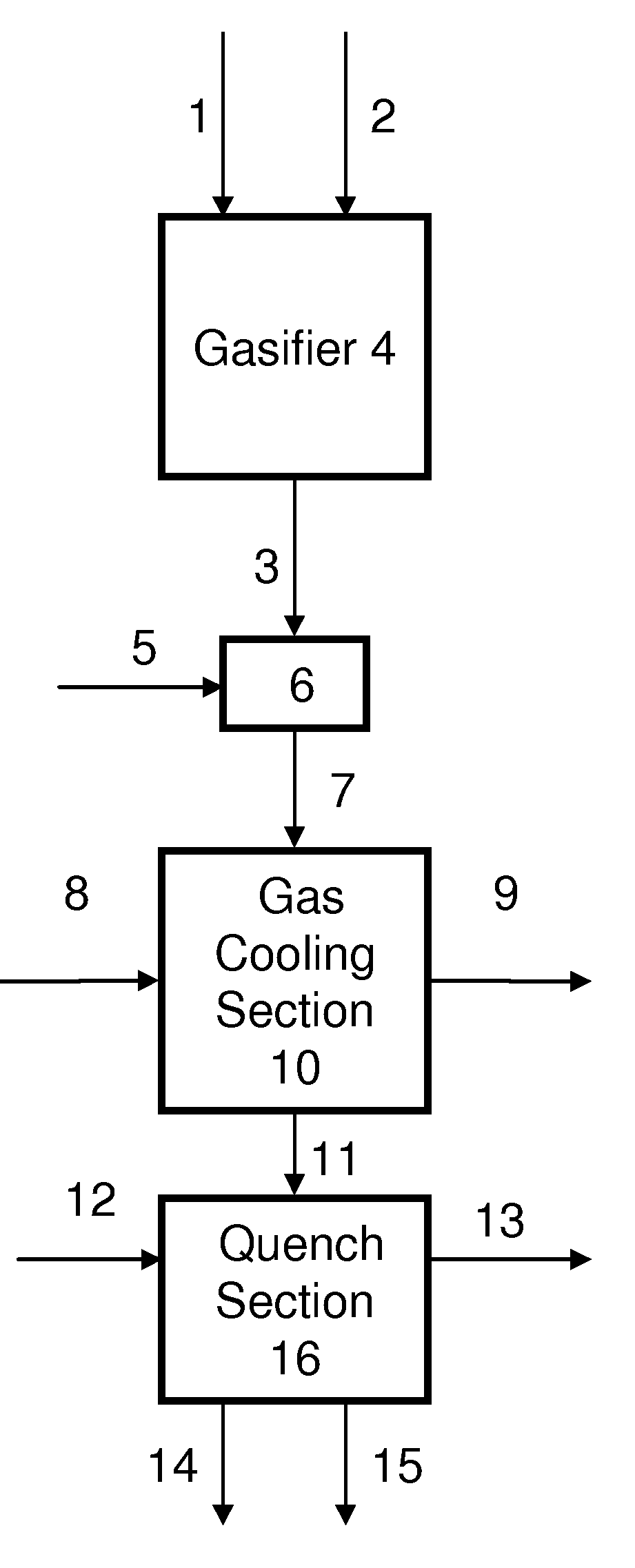Process for humidifying synthesis gas
a technology of synthesis gas and process, which is applied in the direction of combustion air/fuel air treatment, gaseous engine fuel, energy input, etc., can solve the problems of insufficient water, insufficient heat generation, and insufficient energy generation above full quench design,
- Summary
- Abstract
- Description
- Claims
- Application Information
AI Technical Summary
Benefits of technology
Problems solved by technology
Method used
Image
Examples
examples
[0138]General—A better understanding of the invention is provided with particular reference to the examples given below. For Examples 1 through 16, heat and material balance calculations were carried out using process simulation software to illustrate the aspects of the instant invention. The values for temperature, pressure, flow rate, were calculated using standard vapor-liquid equilibrium equations and heat transfer equations known in the art and which may be found in standard engineering texts such as, for example, Perry's Handbook of Chemical Engineering, 6th ed., New York, McGraw Hill, 1984. The following prophetic gas compositions are expected from the indicated gasification conditions: Illinois coal #6 with an expected composition of 61.46 weight % carbon, 12.3% ash, 4.83% sulfur, 12% water, 4.37% hydrogen, 3.87% oxygen, 1.03% nitrogen, and 0.14 weight % chlorine is slurried with water to give an apparent slurry concentration of 64% coal solids. The coal slurry is fed with 0...
examples 1-5
[0147]Examples 1-5 illustrate the effect of varying the diluent flow on the H2O:CO ratio of the humidified syngas when the diluent is water. For examples 1-5, water diluent is combined with the raw syngas and subjected to heat exchange in a gas cooler, and quenched with water to produce a humidified syngas. The gas cooler is designed to remove 7542 BTU / lbmol / hr sensible heat from the syngas at a diluent to raw syngas molar ratio of 0.074:1. The molar ratio of the sum of the quench water flow and water diluent flow to that of the raw syngas is held constant at 2.07:1. The quench water and water diluent temperatures are assumed to be 27° C. less than the calculated quench temperature in all cases. The ratio of molar flow rate of the water diluent to raw syngas is varied from 0:1 to 0.30:1. The results of heat and material balance calculations are summarized in Table 1:
TABLE 1Effect of Diluent Ratio on Humid Gas H2O:CO Molar RatioHumidΔHGCGasKJ / H2O:CODiluentKgmol / TGCinTGCoutMolarTQuenc...
examples 6-8
[0148]Examples 6-8 illustrate the effect of varying the diluent temperature on the H2O:CO ratio of the humidified syngas when the diluent is water. For Examples 6-8, water diluent is combined with the raw syngas and subjected to heat exchange in a gas cooler, and quenched with water to produce a humidified syngas. The molar ratio of the sum of the quench water flow and water diluent flow to that of the raw syngas is held constant at 2.07:1. The temperature of the quench water is assumed to be 27° C. less than the calculated quench temperature in all cases. The results of heat and material balance calculations are summarized in Table 2, with Example 4 for comparison.
TABLE 2Effect of Diluent Temperature on Humid Gas H2O:CO Molar Ratio.Humid GasDiluentTDΔHGCTGCinTGCoutH2O:COTQuenchRatioCelciusKJ / Kgmol / hrCelciusCelciusMolar RatioCelciusExample 40.15:1189.9144561004.2675.72.05212.3Example 60.15:13514188982.3658.31.99211.5Example 70.15:1220144811009.4680.62.06212.5Example 80.17:1351336395...
PUM
| Property | Measurement | Unit |
|---|---|---|
| temperature | aaaaa | aaaaa |
| temperature | aaaaa | aaaaa |
| temperature | aaaaa | aaaaa |
Abstract
Description
Claims
Application Information
 Login to View More
Login to View More - R&D
- Intellectual Property
- Life Sciences
- Materials
- Tech Scout
- Unparalleled Data Quality
- Higher Quality Content
- 60% Fewer Hallucinations
Browse by: Latest US Patents, China's latest patents, Technical Efficacy Thesaurus, Application Domain, Technology Topic, Popular Technical Reports.
© 2025 PatSnap. All rights reserved.Legal|Privacy policy|Modern Slavery Act Transparency Statement|Sitemap|About US| Contact US: help@patsnap.com


